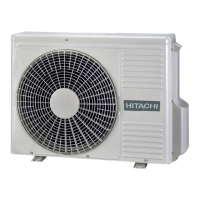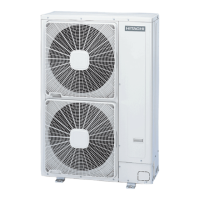What does compressor factor alarm mean in Hitachi RAS-4HVRNME-AF Air Conditioner?
- CCristian ParsonsAug 30, 2025
A compressor factor alarm in your Hitachi Air Conditioner indicates that damage to the compressor has occurred 3 times within 6 hours.

What does compressor factor alarm mean in Hitachi RAS-4HVRNME-AF Air Conditioner?
A compressor factor alarm in your Hitachi Air Conditioner indicates that damage to the compressor has occurred 3 times within 6 hours.
What does hydraulic alarm mean for Hitachi RAS-4HVRNME-AF?
A hydraulic alarm in your Hitachi Air Conditioner indicates that water pressure or water flow is not detected in the hydraulic cycle.
Why my Hitachi RAS-4HVRNME-AF shows undervoltage or overvoltage?
Undervoltage or overvoltage issues in your Hitachi Air Conditioner can stem from abnormalities in the outdoor PCB, inverter PCB, DM, or CB.
What causes unit over-temperature limit protection in my Hitachi RAS-4HVRNME-AF Air Conditioner?
Unit over-temperature limit protection in your Hitachi Air Conditioner is activated if the water supply temperature is 5ºC more than the maximum water circuit temperature for 20 seconds.
What causes freeze protection by cold water inlet temperature detection in my Hitachi Air Conditioner?
Freeze protection by cold water inlet temperature detection in your Hitachi Air Conditioner is activated if the inlet water temperature is lower than 2 ºC.
What causes Opentherm communication failure in my Hitachi RAS-4HVRNME-AF Air Conditioner?
Opentherm communication failure in your Hitachi Air Conditioner is caused if there is no Opentherm communication for a continuous period of 1 minute.
What causes RF communication failure in my Hitachi RAS-4HVRNME-AF?
RF communication failure in your Hitachi Air Conditioner happens when there is no communication for 1 hour with one or two RF receivers which are bound to the RF-Bridge.
What causes unit capacity setting error in my Hitachi RAS-4HVRNME-AF?
Unit capacity setting error in your Hitachi Air Conditioner is caused if there is no concordance between indoor outdoor unit capacity.
What causes LCD H-link transmission error in my Hitachi Air Conditioner?
LCD H-link transmission error in your Hitachi Air Conditioner can be caused by no H-LINK communication for a continuous period of 1 minute between Indoor and LCD User control by connection wiring (breaking, wiring error, etc.).
What causes activation of high pressure switch in my Hitachi Air Conditioner?
Activation of the high pressure switch in your Hitachi Air Conditioner is caused when the high pressure (Pd) is higher than 3.0 MPa.
| Cooling Capacity | 4.0 kW |
|---|---|
| Refrigerant | R32 |
| Power Supply | 220-240V, 50Hz |
| Type | Split |
| Outdoor Unit Dimensions (HxWxD) | 780 mm |
Overview of safety precautions and warnings, including DANGER, WARNING, CAUTION.
Details on system compatibility, manual usage, and policy.
Specifies pressure limits and safety cut-out values for the system.
Highlights risks associated with pressure vessels and safety devices.
Pre-operation checks and precautions for compressor and system.
Includes 3-minute guard and auto restart after power failure.
Covers frost prevention, slow air control, and hot start during heating.
Details automatic defrosting cycle and overload prevention.
Immediate actions for smells or white smoke from the unit.
Describes normal sounds and steam generation.
Troubleshooting steps for no operation.
Checks for common cooling/heating performance issues.
Information to provide to service contractor.
Identifies components of the outdoor unit with diagrams.
Diagram illustrating the refrigerant flow and components.
Guidelines for installing outdoor units safely and effectively.
Clearance requirements for single units with blocked inlets.
Clearances for multiple units with blocked inlets.
Clearance requirements for single units with open upper side.
Clearances for multiple units with open upper side.
Clearance requirements for single units with blocked upper side.
Clearances for multiple units with blocked upper side.
Clearance for single units with blocked outlet side.
Clearances for multiple units with blocked outlet side.
Clearance for single units with blocked lateral side.
Clearance for stacking units vertically, single or multiple.
Clearance for units installed in multiple rows.
Requirements for concrete foundation and base installation.
Instructions for wall mounting the outdoor unit.
Guidelines for suspending the outdoor unit.
Recommendations for installing units in windy locations.
Details on selecting and preparing copper pipes for the system.
Methods for suspending refrigerant piping to prevent damage.
Procedure for connecting pipes to the outdoor unit from different directions.
Instructions for mounting piping cover to prevent water entry.
Specifications for tightening torque of pipe connections.
Chart for determining piping length based on height difference.
Procedure for setting pipe length using DSW2.
Specifications for gas and liquid pipe sizes for indoor/outdoor units.
Guidelines and precautions for pipe brazing with nitrogen gas.
Procedure for pressure measurement using check joints.
Warnings regarding charging gases and potential hazards.
Table of factory refrigerant charge amounts and pipe lengths.
Procedure for collecting refrigerant for relocation.
Description and connection procedure for the drain boss.
Important notes regarding drain boss usage in cold areas.
General checks for electrical components and compliance.
Precautions for wiring terminal blocks and electrical parts.
Safety warning about connecting/adjusting wiring with power off.
Diagrams for electrical wiring connections to outdoor units.
Details on the location and types of DIP switches on the PCB.
General wiring practices and compliance with local codes.
Instructions for wiring between indoor and outdoor units.
Attention to operating line connection for correct PCB function.
Recommended minimum wire sizes for field-provided wires.
Checks before performing the test run.
Visual inspection of the unit for damage and installation status.
Checks related to electrical resistance and connections.
Verification of stop valves, piping, and refrigerant charge.
Warning not to operate until all checks are cleared.
Procedure to configure and start the test run from the remote control.
Explains DSW1 settings for test run, operation mode, and compressor control.
Procedure for manually initiating and ending defrost operation.
Warnings about touching PCB and service covers during operation.
Details on high pressure switch and control circuit fuses.
Explanation of fan motor output reduction based on thermistor temperature.
Overview of alarm codes displayed on the remote control.
Troubleshooting table for various alarm codes and their causes.
Troubleshooting table for various alarm codes and their causes.











